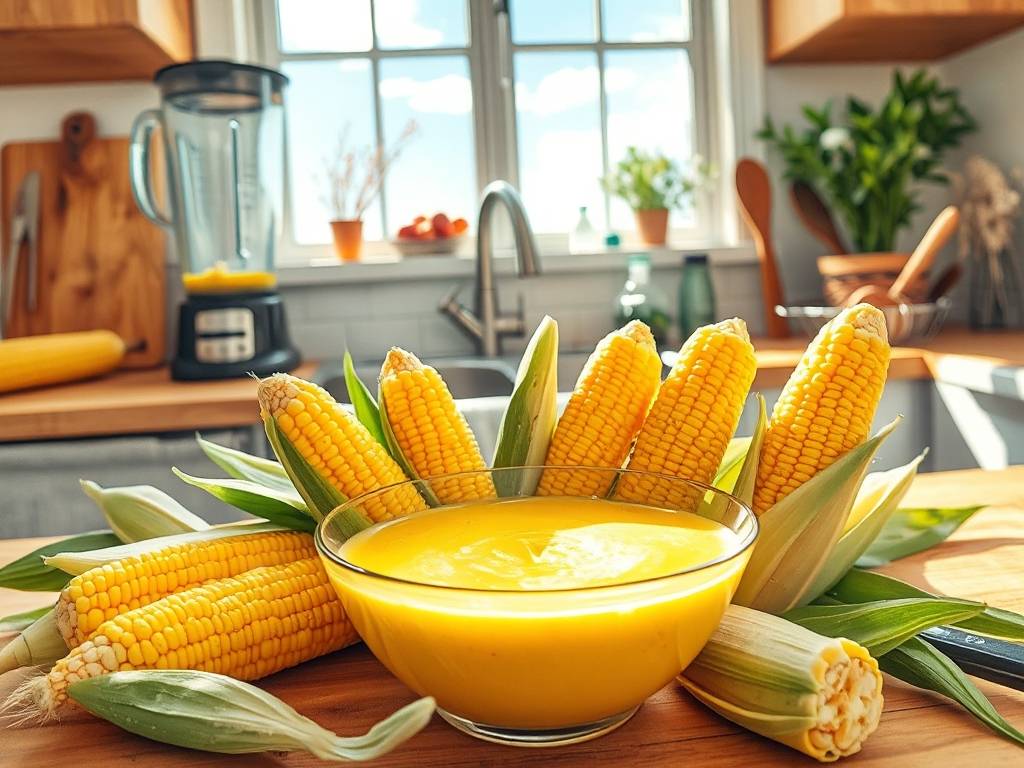The Art of Making Smooth and Sweet Corn Soup from Fresh Corn
There is something deeply comforting about a warm bowl of corn soup. Its creamy texture, natural sweetness, and golden hue make it a beloved dish across cultures. While canned corn soup might be convenient, nothing compares to the vibrant flavor of soup made from fresh corn. This guide will walk you through the process of creating an exceptional corn soup that highlights the natural sweetness of fresh corn, achieved through careful blending and cooking techniques.
Why Fresh Corn Makes All the Difference
The foundation of any great corn soup is, undoubtedly, the corn itself. Fresh corn on the cob brings a sweetness and depth of flavor that canned or frozen corn simply cannot match. When corn is freshly harvested, its sugars are at their peak. As time passes, these sugars convert to starch, diminishing the corn's natural sweetness. This is why using fresh corn is non-negotiable for the best results.
Selecting the right corn is crucial. Look for ears with bright green, snugly fitting husks and golden-brown silk. The kernels should be plump and tightly packed. When you press a kernel, it should release a milky liquid – this indicates perfect ripeness. Many farmers' markets and grocery stores now label corn with its harvest date, allowing you to choose the freshest possible ears.

Preparing Your Corn
Begin by shucking the corn, removing all husks and silk. Rinse the ears under cool water to remove any remaining silk strands. The traditional method involves cutting the kernels from the cob, but there's a better way to maximize flavor: grating.
Using a box grater placed in a large bowl, gently grate the corn cobs. This technique extracts both the kernels and the precious milky liquid that often gets left behind when simply cutting kernels. This liquid is packed with flavor and will contribute to the soup's creamy texture without needing excessive cream or thickeners.
Don't discard the cobs after grating! They still hold tremendous flavor. Break them in half and set them aside – they'll be used to make a corn stock that will form the base of your soup.
Creating the Corn Stock
A homemade corn stock elevates the soup from good to extraordinary. In a large pot, combine the spent corn cobs with:
- 1 quartered onion (skin on for color)
- 2 celery stalks, roughly chopped
- 1 carrot, roughly chopped
- 2 garlic cloves, smashed
- A few sprigs of fresh thyme
- 1 bay leaf
- 8 cups of water
- 1 teaspoon of whole black peppercorns
Bring this to a boil, then reduce to a simmer for about 45 minutes. The cobs will infuse the water with their corny essence, while the vegetables add depth and complexity. Strain the stock through a fine-mesh sieve, pressing on the solids to extract all the flavorful liquid. You should have about 6 cups of beautifully golden corn stock.
Building Flavor Layers
Now comes the magic of building flavors. In a heavy-bottomed pot, melt 3 tablespoons of butter over medium heat. Add 1 diced onion and cook until translucent but not browned, about 5-7 minutes. Add 2 minced garlic cloves and cook for another minute until fragrant.
Stir in your grated corn (with all its milky liquid) and cook for 5 minutes, allowing the corn to release its natural sugars and develop a deeper flavor. The aroma at this stage is incredible – sweet and buttery with a promise of the delicious soup to come.
The Blending Process: Achieving Perfect Smoothness
Here's where the transformation happens. Add 4 cups of your corn stock to the pot (reserve the rest for adjusting consistency later) and bring to a simmer. Cook for 15-20 minutes to allow the flavors to meld.
Now for the crucial blending step. Working in batches, carefully transfer the soup to a blender. Never fill the blender more than halfway when working with hot liquids, and always hold the lid firmly in place with a kitchen towel to prevent accidents.
Blend each batch until completely smooth. This may take 1-2 minutes per batch. For an ultra-silky texture, pass the blended soup through a fine-mesh sieve, pressing with a spatula to ensure you get all the liquid while leaving behind any fibrous bits.
Enhancing Natural Sweetness
The blending process doesn't just create smoothness – it actually helps release and distribute the corn's natural sugars throughout the soup. But we can enhance this sweetness further with a few thoughtful additions:
A small diced potato added during cooking will break down and contribute both creaminess and subtle sweetness. A quarter cup of heavy cream added at the end enriches the soup while complementing the corn's natural flavors. A pinch of white pepper enhances the sweetness without adding heat, while a tiny amount of nutmeg (about ⅛ teaspoon) works wonders to highlight the corn's natural flavor profile.

Perhaps the most important trick for maximizing sweetness is patience. Allow the soup to simmer gently rather than boiling vigorously. High heat can cause the sugars to caramelize too quickly, leading to bitterness rather than sweetness.
Finishing Touches and Serving Suggestions
Return the sieved soup to a clean pot and heat gently. If the soup seems too thick, add some of your reserved corn stock until it reaches your desired consistency. Season with salt to taste – this will make the natural sweetness pop even more.
For serving, consider garnishes that complement without overwhelming: a drizzle of cream, fresh chopped chives, a sprinkle of smoked paprika, or some homemade croutons for textural contrast. For a special touch, top with some sautéed corn kernels reserved from your initial preparation.
Variations and Adaptations
While the classic version is divine, corn soup welcomes creativity:
For a spicy twist, add a diced jalapeño when cooking the onions. For herbaceous notes, stir in fresh basil or cilantro at the end. For added richness, swirl in a tablespoon of mascarpone or cream cheese per serving. For a vegan version, use olive oil instead of butter and coconut milk instead of cream.
Storing and Reheating
Corn soup stores beautifully. Cool completely before transferring to airtight containers. It will keep in the refrigerator for up to 4 days or in the freezer for 3 months. When reheating, do so gently over medium-low heat, stirring occasionally. You may need to add a splash of water or stock as the soup tends to thicken when refrigerated.
The Reward of Homemade
Making corn soup from fresh corn requires more effort than opening a can, but the difference is astronomical. The vibrant yellow color, the intense corn flavor, the natural sweetness that needs no artificial enhancers – these are the rewards of your labor. Each spoonful tastes like summer captured in a bowl, a celebration of corn at its peak.
This process of selecting fresh corn, creating homemade stock, carefully building flavors, and blending to perfect smoothness results in a soup that is both sophisticated and comforting. It demonstrates how simple ingredients, treated with respect and care, can transform into something extraordinary. So the next time you see fresh, sweet corn at the market, bring some home and experience the joy of creating this beautiful soup from scratch. Your taste buds will thank you.






发表评论